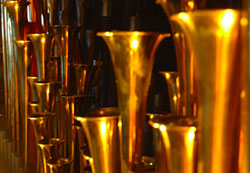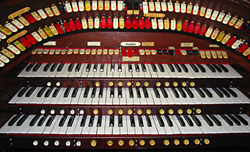The Wurlitzer Brass Pipe Organ Revival at the City Museum
 Brass organ pipes of the restored Wurlitzer
Brass organ pipes of the restored Wurlitzer Photograph courtesy of City Museum
Of the more than 5,000 organs manufactured in the early 1900s, only a few hundred remain in public venues. Fortunately the City Museum in St. Louis has a recently restored Wurlitzer Brass Pipe Organ which still performs to enthusiastic crowds.
Alan Haker is the organ custodian for the City Museum who designed and did most of the installation. "The organ had been in storage for 18 years and we kept trying to find a home for it," he said.
He approached the City Museum who jumped at the chance. Preparations began for installing the organ in a part of the museum known as The Enchanted Caves, a 10 story atrium in the middle of the museum. The first two floors are a labyrinth, hence the name Caves. The remainder is open with chutes and slides and a skylight on the roof. Some original pipes were discarded due to space constraints.
There are currently 17 sets of pipes, with a mélange of different materials like brass, wood, tin and lead combinations, and zinc alloy. "The tin and lead pipes make a mellower sound, the more ponderous tones need eight foot brass pipes, three inches in circumference," Haker noted.
 Wurlitzer keyboard
Wurlitzer keyboard Photograph courtesy of City Museum
The result is a pipe organ that has new life and is winning new converts.
"The teenagers love it," Haker says, though the first thing the younger kids ask is, will it play Freebird? Sadly, no. Most organs are geared for musicals, songbook tunes and Disney songs. Though the Wurlitzer is computer operated—there's a PC in the console—the City Museum still gets a live organist about once a week to play hands on. "The first day it played," Haker says, "[The museum's owner] Mr. Cassilly came up and gave me a big hug." And for centuries, pipe organs and the brass that create the must-have strident deep notes have been and will continue to be a part of history.
Resources:
Also in this Issue:
- Meet the Signature Copper Artists of Artist House
- J Crocker Designs: Shedding an Eco Friendly Light on Copper
- Roland Hockett: Experiments with Copper
- The Wurlitzer Brass Pipe Organ Revival at the City Museum
- Bronze by Barye on Exhibit at MIA
